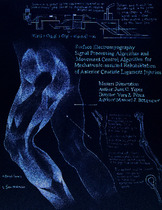| dc.contributor.advisor | Pérez, Vera Z. | |
| dc.contributor.advisor | Betancur, Manuel J. | |
| dc.contributor.author | Yepes, Juan C. | |
| dc.coverage.spatial | Seccional Medellín. Escuela de Ingenierías. Maestría en Ingenierías | spa |
| dc.date.accessioned | 2018-11-30T17:17:51Z | |
| dc.date.available | 2018-11-30T17:17:51Z | |
| dc.date.issued | 2018 | |
| dc.identifier.uri | http://hdl.handle.net/20.500.11912/4193 | |
| dc.description | 100 páginas | spa |
| dc.description.abstract | The knee is the most complex and largest joint in the human body, and it depends on four primary
ligaments. One of the main ligaments is the Anterior Cruciate Ligament (ACL). A direct blow to
the knee is one of the ways to injure the ACL, for example during football or a traffic accident.
Nevertheless, most ACL injuries happen even without any contact with another object.
There are many traditional methods and devices to assist treatment. Nevertheless, robot-assisted
therapy (RAT) rehabilitation, simulating normal walking to examine the effects of long-term interventions
on functional activity levels after ACL reconstruction, improves the walking ability, the
balance ability, and the extensor strength after ACL reconstruction. However, ACL injuries require
various rehabilitation phases. Therefore, there is the need to perform RAT or mechatronic-assisted
rehabilitation of ACL Injuries during other phases of the rehabilitation before attempting an advanced
exercise such as walking, e.g., when the subject tries to make a knee movement and is not able
to execute it, due to the pain caused by the injury. In this rehabilitation phase, an active-assisted
rehabilitation exercise must be conducted.
The specific problem addressed in this thesis is to detect the motion intention and control
a mechatronic rehabilitation system to assist the knee movement, i.e., such as in active-assisted
extension exercises but using an exoskeleton. | spa |
| dc.format.mimetype | application/pdf | |
| dc.language.iso | eng | |
| dc.rights | Attribution-NonCommercial-NoDerivatives 4.0 International | * |
| dc.rights.uri | http://creativecommons.org/licenses/by-nc-nd/4.0/ | * |
| dc.subject | Robótica -- Aplicaciones | spa |
| dc.subject | Procesamiento de señales biomédicas | spa |
| dc.subject | Señales biomédicas | spa |
| dc.subject | Electromiografía | spa |
| dc.subject | Ligamento Cruzado Anterior -- Lesiones -- Rehabilitación | spa |
| dc.subject | Ligamento Cruzado Anterior -- Lesiones -- Terapia | spa |
| dc.subject | Ingeniería biomédica | spa |
| dc.subject | Terapia asistida por computador | spa |
| dc.subject | Mecatrónica | spa |
| dc.subject | Nukawa (Proyecto de investigación) | spa |
| dc.title | Surface electomyography signal processing algorithm and movement control algorithm fo mechatronic-assisted rehabilition of anterior cruciate ligament injuries | spa |
| dc.type | masterThesis | spa |
| dc.publisher.department | Escuela de Ingenierías | spa |
| dc.publisher.program | Maestría en Ingenierías | spa |
| dc.rights.accessRights | openAccess | spa |
| dc.type.hasVersion | draft | spa |
| dc.description.sectional | Medellín | spa |
| dc.identifier.instname | instname:Universidad Pontificia Bolivariana | spa |
| dc.identifier.reponame | reponame:Repositorio Institucional de la Universidad Pontificia Bolivariana | spa |
| dc.identifier.repourl | repourl:https://repository.unab.edu.co/ | |
| dc.description.degreename | Magister en Ingenierías | spa |


